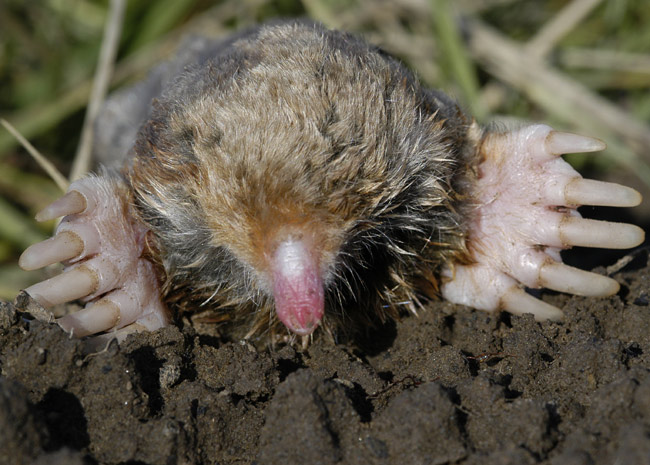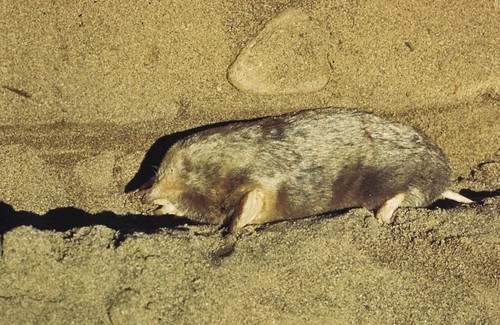
8:00 p.m. - 2007-09-09
Molez
Howdy, critter fans!
How are you? Is your fall routine in full force?
Things are settling down over here. But the critters are on a schedule all their own!
Any sightings? PG and I spotted a pudgy marmot on the W. River Road Friday night. Earlier that day I saw a black squirrel leaping along 35E.
Special shout-outs to D and WT, who were married yesterday. They're headed to Hawaii, where critters abound! D and W have promised a full report.
Both at the State Fair last week and last night at the wedding we spoke to the B family about a special critter problem they're experiencing in their lovely yard. Well, the critters happen to be damaging the yard itself: A mole infestation!
So, today we will learn about these little diggers!
These insectivores have five representatives in North America. Most likely the B family is host to the above mole, the eastern variety. MN is also home to this crazy looking star nosed mole!
I'm serious. (Except star nosed moles like moist habitats adjacent to water, so they might not be the culprits.)
Moles are five to eight inches long out here, but can reach over nine inches in the western species. Like pigs, male moles are called boars and females called sows. A group of moles is called a labour of moles!
Moles are very ancient members of the mammals, with a fossil record dating back 30 million years in North America and 50 million years in Europe.
Mostly solitary, moles dig two types of tunnels. The first type is the shallow feeding chute that leaves a convex ridge in my friends the B's lawn! Rather than chasing down earthworms and insects in these tunnels, the moles feed on the bugs that happen to fall into them! During the summer these tunnels are shallow, and deepen during the winter as the bugs dig further down.
The second type of mole tunnel may be three feet down, and holds their permanent sleeping chambers and hidey holes to avoid predators. These deeper tunnels protect the invertebrates from the cold of winter. Moles also may dig vertical shafts to remove piles of dirt. (B's, do you have any of those in your yard?)
The star nosed mole may be more social than the eastern species, with sow/boar couples hanging out during the winter months. Usually the female mole becomes fertile only in the early spring, and the lucky male ensures his baby-daddy status by inserting a sort of plug into the females vagina after intercourse, preventing her from receiving another male. Two to six offspring result four to six weeks later. Like some other animals, moles reproductive, urinary and digestive tracts all are accessed through one hole, the cloaca.
Females build a nest hole within one of her deeper tunnels and nurses the babies as well as bringing them food. They leave her after five weeks.
Other than tearing up lawns, moles can also damage waterways, crops, silage, as well as digging up rocks that can break farm equipment. Apparently they avoid the castor plant and castor oil, which contains the poison ricin, but I don't know if that would be an option for the B's as they have a munchkin, dog and cat. I guess cat litter can be a mole deterrent as well as blood meal. Both live and killing traps are available for moles too.
I suggested the B family get some weasels to put down the mole-holes! Other animals that attack moles are foxes, owls, skunks, hawks, snakes and domestic dogs and cats. In fact, the B's think their gray cat, "Pepe" escaped into the yard and received a nose-scratch from a mole! Nice try, "Pepe"!
Mole Fun Facts:
*In England, moles are called moldywarps.
*A mole may eat its weight in food per day.
*Moles will eat small mice that enter their tunnels.
*In the 19th century the U.S. used to import four million moleskins from Europe.
*Moleskins were used for hats, trim, tobacco pouches and purses.
*Moles are protected in Germany due to this; most moleskins now come from Russia.
*Star nosed moles can locate, catch and eat prey faster than the human eye can see.
*Moles have the most sensitive snouts around.
I hope you've learned something about these fossorial, or underground-living mammals! Hopefully the B family will report how they handle their moleitude.
Have a great critter day!
xoxoxox
Wendell!



